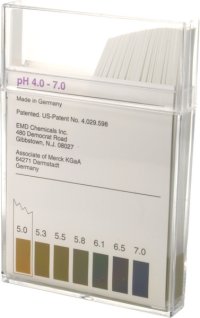Kaiser
Well-Known Member
I need your help.
I think that EMDs colorpHast strips are the best value for home brewing pH measurement unless you really want to take very precise control over your pH. But even if you have a pH meter you should have these strips as a back-up. They are maintenance free, require no calibration and batteries. They are also fairly easy to read with a +/- 0.15 pH precision. At least I think so.
But a while back I ran an experiment that compared colorpHast strips against a pH meter and I found that the colorpHast strips that I have were off by about 0.3 pH units across a wide pH range. Recently other brewers sent me some of their strips and I noticed a similar error. I now have the hunch that colorpHast strips are always off by 0.3 pH units (i.e. they match color that corresponds to a pH 0.3 units lower than the actual pH. For example you read 5.3 on the strip but the meter reads 5.55). Id like to confirm that to issue a general guideline that you should correct the reading of the strips by +0.3 pH (or whatever the mean turns out to be).
So Id like to test this on as many of these strips as I can. Here is my plan:
- If you are interested in participating post here and Ill PM you my address. (For privacy reasons I may not give my address to members who joined after this has been posted)
- Place 2-3 strips in an envelope addressed to me. They have to be of the 4-7 pH kind as sown below
 http://braukaiser.com/wiki/images/f/f4/Colorphast.jpg
http://braukaiser.com/wiki/images/f/f4/Colorphast.jpg
these are the strips that I have
- Ill then assign each group of strips a number and note the number on your envelope (having a return address or a note with name would be helpful)
- Then I prepare 2 small mashes. One with a pH of ~5.3 and the other one with a pH ~5.8 and dip all the strips in these mashes for the same time
- the mashes will also be tested with a calibrated pH meter.
- finally I take them all out, wipe off residual wort and take a picture of all the strips in day light along with the color scale I have for my strips
- Ill do the same with a sample of beer (pH ~4.1-4.5)
- The result will be published and I will let each participant know the number of their strips.
To me that sounds like a very valuable experiment and the participation cost is the cost of 3 strips and a stamp.
So, who is in?
This invitation is going to be posted on the NB forum as well to broaden the base. And dont worry, this is not a scam
Kai
I think that EMDs colorpHast strips are the best value for home brewing pH measurement unless you really want to take very precise control over your pH. But even if you have a pH meter you should have these strips as a back-up. They are maintenance free, require no calibration and batteries. They are also fairly easy to read with a +/- 0.15 pH precision. At least I think so.
But a while back I ran an experiment that compared colorpHast strips against a pH meter and I found that the colorpHast strips that I have were off by about 0.3 pH units across a wide pH range. Recently other brewers sent me some of their strips and I noticed a similar error. I now have the hunch that colorpHast strips are always off by 0.3 pH units (i.e. they match color that corresponds to a pH 0.3 units lower than the actual pH. For example you read 5.3 on the strip but the meter reads 5.55). Id like to confirm that to issue a general guideline that you should correct the reading of the strips by +0.3 pH (or whatever the mean turns out to be).
So Id like to test this on as many of these strips as I can. Here is my plan:
- If you are interested in participating post here and Ill PM you my address. (For privacy reasons I may not give my address to members who joined after this has been posted)
- Place 2-3 strips in an envelope addressed to me. They have to be of the 4-7 pH kind as sown below

these are the strips that I have
- Ill then assign each group of strips a number and note the number on your envelope (having a return address or a note with name would be helpful)
- Then I prepare 2 small mashes. One with a pH of ~5.3 and the other one with a pH ~5.8 and dip all the strips in these mashes for the same time
- the mashes will also be tested with a calibrated pH meter.
- finally I take them all out, wipe off residual wort and take a picture of all the strips in day light along with the color scale I have for my strips
- Ill do the same with a sample of beer (pH ~4.1-4.5)
- The result will be published and I will let each participant know the number of their strips.
To me that sounds like a very valuable experiment and the participation cost is the cost of 3 strips and a stamp.
So, who is in?
This invitation is going to be posted on the NB forum as well to broaden the base. And dont worry, this is not a scam
Kai









